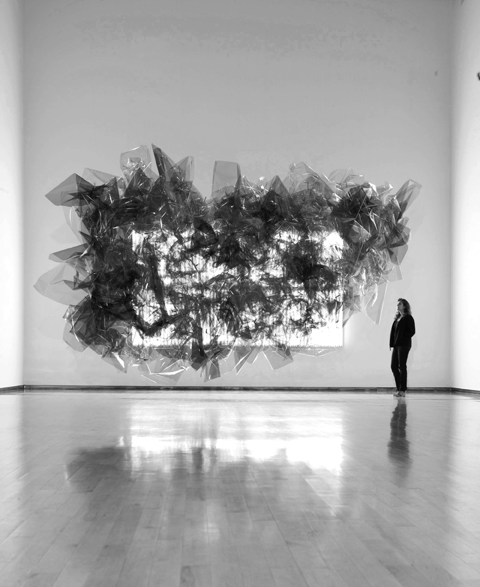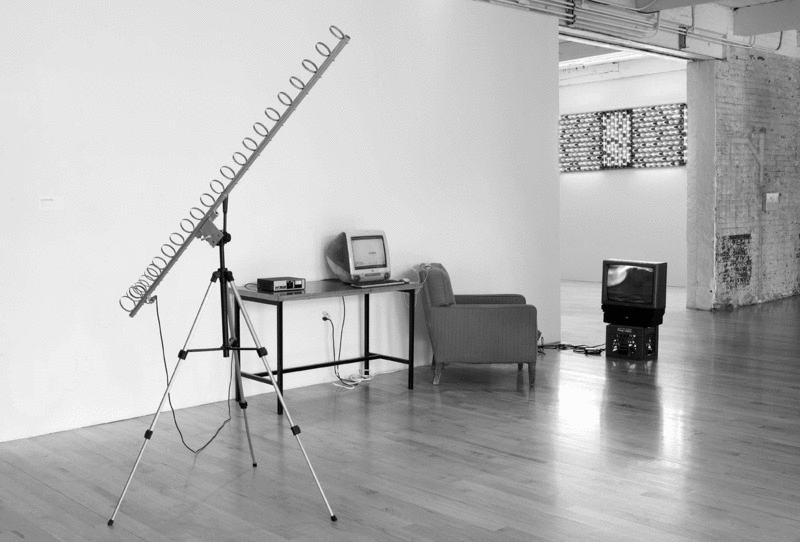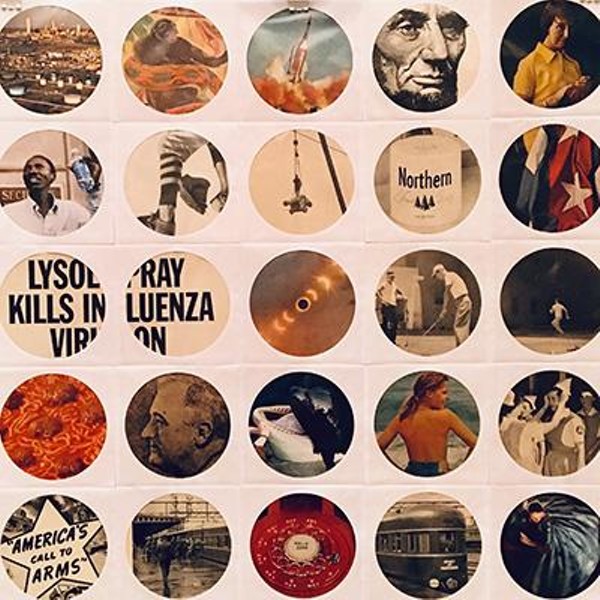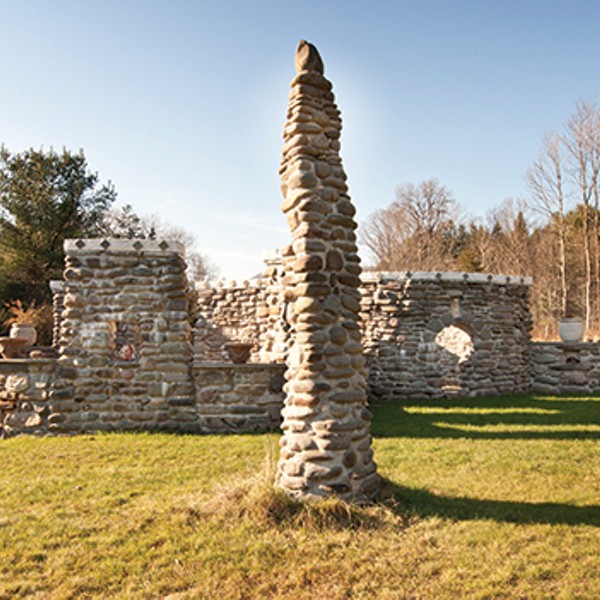Editor’s note: Spencer Finch is a conceptual artist whose principal interests are observation and perception. Finch’s art takes a variety of forms, from works on paper to sculptural objects to set design, but his main medium is installation. Finch constructs environments designed to depict nonvisual experiences in visual terms: a wall of electric fans means to express the breeze on Walden Pond, a constellation of light bulbs recalls a night in the Painted Desert, a blossom of blue balloons signifies an autumn sky over Coney Island. A 1989 MFA graduate of the Rhode Island School of Design, Finch’s work is on exhibit in “What Time Is It on the Sun?” a midcareer retrospective at MASS MoCA. When Chronogram asked Troy artist Michael Oatman to view the Finch exhibit and write his impressions, he focused on a single piece, “Sunlight in an Empty Room (Passing Cloud for Emily Dickinson, Amherst, MA, August 28, 2004),” and delivered a two-part conversation about that work and Finch’s art overall. Oatman’s title for the article, “Begin Morning Civil Twilight,” is taken from an aeronautics term designating, roughly, the time of day about a half hour before sunrise. As Oatman explains it: “Some years ago, I found a military handbook that featured the following term: BMCT, or Begin Morning Civil Twilight. It means ‘the period of time at which the sun is halfway between beginning morning (nautical twilight) and sunrise, when there is enough light to see objects clearly with the unaided eye. At this time, light intensification devices are no longer effective, and the sun is six degrees below the eastern horizon.’ Seeing Finch’s work reminded me of this term. I was struck by the notion that there are still moments in our experience of nature when the human eye is more sensitive, more capable, than any instruments we have devised.” Finch’s work is on view at MASS MoCa through spring 2008.
One-Day Diary
8:08 AM
Today is August 28, 2007, and for two weeks I have been trying to juggle my schedule to take a trip to Emily Dickinson’s home in Amherst, Massachusetts.
Four years ago, artist Spencer Finch was at her house on the same day; that visit materialized in a work now on view at MASS MoCA. Sunlight in an Empty Room (Passing Cloud for Emily Dickinson, Amherst, MA, August 28, 2004) is one of many of his installations that translate his experiences at sites around the world into physical objects. There are drawings of “darkness,” stacks of fans that simulate a hillside breeze, and windows with lighting gels that “color match” flickering candlelight. “What Time Is It on the Sun?” the first survey of Finch’s work, was organized by MASS MoCA curator Susan Cross, who also produced the artist’s first monograph.
Passing Cloud is a simultaneously daunting and sylvan artwork. A bank of fluorescent lights is blocked and revealed (depending on the viewer’s location) by a massive hanging assemblage of blue theatrical gels, a cloud held together by clothespins: a homemade weather front.
At the show’s opening, a little girl crawled under the cloud. I remember her quite vividly: about six years old, wearing a light blue and spring green paisley jumper. She was dressed for a party, and clearly had no reservations about this work. She turned over and stared up into the underbelly of the cloud. I said to someone, “She’s got the best view in the whole museum. I wish the rest of us could see it that way.” Later, getting into the same position, I became lost in three reveries: seeing what the girl had discovered; seeing what the artist saw; and, finally, engaged by my own memory of a particular place. Moving in, around and under that cloud, enveloped in the cool blue light, I emerged occasionally into the white blast furnace of the fluorescents: It was like my experience at a beach in Italy some years ago. Physically, I was at the museum; mentally I was an ocean away.
1:10 PM
Spending an hour or two with a single artwork is a rare gift in this age of more, faster, louder. A former colleague, the painter Frank Owen, once remarked that, all told, he had probably spent about a day in front of Picasso’s Les Desmoiselles d’Avignon. I too have spent a significant amount of time on that bench in the Museum of Modern Art. If you go and see Spencer Finch’s work at MASS MoCA, make sure you let your eyes adjust in each new situation as you move from room to room. Slow down. You might discover, as I did, that the monofilament supporting the cloud, under certain lighting conditions, appears as rain falling up.
9:30 PM
I was not able to change my schedule to be at Dickinson’s house today. In the end, I’m not really sure why I wanted to go. It wasn’t to check on the accuracy of Finch’s perceptions; as a quality, accuracy has never really moved me much in art. No, I think I wanted to “add together” the place and the artwork, the inspiration and the result. To be in a place that he thought worthy of evoking in everyday materials, made new.
What I realized about Spencer’s work is this: It tends to disappear as you’re looking at it. There you are, in front of real materials, undeniable physicality, and suddenly you’re thinking about your personal encounters with nature, with light, with place—remembering your own history. As if summoned by the recent round of films about magicians, illusionists, and con men, Finch and his work have come to the Berkshires not to deceive, but to inspire and elate. For those who are lamenting the passing of summer, there will be, for many months to come, vignettes of different weathers and remote vistas, conjured up by a man with a bird’s name.
Spencer Finch turns “seeing the ordinary” into an event.
A CONVERSATION WITH SPENCER FINCH
I met Spencer Finch at his Brooklyn studio, located somewhere near the Gowanus Canal, between Park Slope and Red Hook. I found him working in the sunlight, making watercolor studies for a new project. Although he declined to be photographed, I immediately warmed to his cheerful demeanor. He continued to paint while we spoke.
Michael Oatman: What is your earliest visual memory? Other than impressions, what is the first thing that registered in a really significant way?
Spencer Finch: I think the earliest one—it’s for a project based on color memory—the earliest one that I got to was a small, blue, toy telephone that was my sister’s when we were kids. An image of this small, blue phone that was hers, and she’s three years younger than me so I must have been at least three. She was a baby. I don’t think I remember anything earlier than that.
It’s curious that your first visual memory is about something that’s associated with sound.
(Finch laughs.)
Already there’s this sort of switch going on. Along those lines, what’s the first memory you have that’s triggered by some other sense?
Oh, smell. All sorts of memories. It’s funny, because last weekend I was in Vermont, at my parents’ place, and I was helping my mom dig some stuff up in the garden, and just that smell of soil—the smell of soil in Vermont—in that place in Vermont, is very different from anywhere. So, if I was digging soil in Brooklyn, which doesn’t often happen, but it has, it’s different. That smell of soil is something that goes back to my childhood because I’ve been going there since I was an infant. I’m interested in that real, direct, olfactory link to the landscape. There is that very close link between memory and smell.
And have you made any works that relate to that sense?
I’ve done a bunch of drawings trying to create a visual equivalent to smell. The interesting thing about smell is that you can’t get it all at once. Smell really exists in time the way a visual image doesn’t; the smell of something is like taste—as food moves through your mouth, the taste develops. It’s really more diachronic than sight is, so what I was trying to do was make these drawings that created this sense of smell shifting in time. The first ones I did were of the Gowanus Canal here, when it smelled—it used to be really polluted. At this time of year it used to totally reek. And then I did some that were sort of “Postcards of New York.”
That’s a funny idea.
Part of what interested me about it is that it’s a somewhat arbitrary idea of representing something, at the same time I feel that other conventions we use to represent things, whether it’s photography or perspective, are also problematic.
I’m glad you brought up the arbitrary, because the more time I spend with your work, I realize there is an interesting hybrid of the technical and the subjective. But it never slips into that purely analytical mode; it’s always poetic, which I imagine is really important to you. I mean, as a viewer, I don’t feel you out there with the slide rule or something.
Yeah, I think it’s very odd. There’s a sense that I need to go and see something for myself, and that I feel really strongly. I guess it comes from a deep-seated distrust of any sort of secondhand opinion or other form of representation. And so in that way it is very direct. I also feel that all instruments lie; and whether that is a scientific instrument or my own perceptual apparatus, I feel that it lies. But rather than get angry about that, I think it’s sort of a beautiful thing, that slippage ... these gaps of translation.
Since I’m so interested in the work being related to the world, it’s not so much about my—I mean, it is, inevitably—but it’s not so much about my inner world, not so much about self-expression. It’s not really “channeling” (laughs), but it’s more like finding a way of looking at the world and representing it somehow. It is very important though, that things be as accurate as possible. But when you’re “drawing smell as accurately as possible,” there’s something sort of absurd about it. Or “drawing darkness.” I work very precisely, and, in a sense, do adopt the scientific method, which is trial and error, but there’s a lot of error in there. I keep the error, I think, and a scientist would throw it out. All those experiments that come out way off the graph are the great ones.
They’re clipping the ends off the bell curve, and you’re gathering them in.
Right.
I guess this may be one of those questions you get asked a lot: Which comes first, the idea of going to a place and then doing the piece, or having been at a place and then wanting to do a piece? Or, do you have to go back, deciding after an experience that you want to make a work out of it?
Sometimes I go back, but almost always the concept comes first. The idea, even before the place. I mean, some things, like with Emily Dickinson, I had this huge admiration for her, but I didn’t have any idea of doing something there. However, I did have this concept of a passing cloud; this idea, which is something I’ve loved that feeling of, ever since I was a kid, especially in summer: how a passing cloud can totally change everything. I didn’t know what to do with it. And then I was reading a lot of Emily Dickinson a couple of years ago, and it occurred to me that that was something she would be so attuned to and so sensitive to that I wanted to see what a passing cloud would look like in her garden. Because I wanted to see what she saw, really. So it was this sort of voyeuristic thing.
There’s a lot of content bound up in the choice of Emily Dickinson, her work, and the way that people feel about her. She may be one of the few people from her era that a lot of people will still point to and say that they know something about her. You’ve also made works in reference to places from history/mythology, like your sculpture Troy. Is the choice of Troy (as a site) coming out of a learned, “earned” historical tale that we carry around with us?
Yes, Troy was also taken from something that I wanted to do for almost 10 years. That actually came out of more modern poetry—people like Auden, who thought a lot about Troy, and used it. I was interested in the way that certain poets were able to reference those ancient texts, and also ancient actions and places, and make them modern, in a way. There’s this poem by Auden where he talks about the shield of Achilles, the design that Hephaestus put on the shield, and how horrible it is. Because it’s all about killing, and how this warrior who will not live long has this beautiful shield. But it’s all so brutal, and it’s so much about the world, but not the world that we wish it were about. I find it easier to speak about things indirectly that way, and also, when you’re doing it with history, it’s less topical. I find it somewhat dangerous to get too topical.
How do you feel about humor? The Troy piece at the end of the hallway, way up high: Something about where it’s located, and its proximity to other mechanical stuff that the building needs to run on, seems so goofy and so appropriate; I really liked that, and yet it duplicates the light of this legendary place. That device for dropping apples, and the plop sound it makes, is also very funny. Can you talk about how the concepts behind your work—light, breeze, darkness—ideas that most people regard as ephemeral—are framed by things, objects?
I’m trying to make it as matter-of-fact as possible. And also I do everything myself, as much as possible. Programming of that wind piece had to be done by someone else. It uses a DMX [digital mixing] system that’s normally used for lights. It was actually very simple. It took the guy, like, 45 minutes to program. The apple dropper is these really simple motors, and I put it together with a friend. It uses BASIC [an early computer programming language], and I just wasn’t able to do the programming.
There’s something nice about an “apple-dropping machine” being programmed in BASIC, as if it’s going back to original sin, or school.
(Laughs.) And all the electronics I put in Tupperware so you can see them.
Lock in freshness.
Of course, it’s always an aesthetic decision, and that decision, always in my case, leans toward the minimal, not the decorative. But it’s also about the integrity of materials, which is something that came from my training: that you don’t try to hide things too much, you sort of have it out there so people will know. People are also curious about that. … I’m not interested in smoke and mirrors. ... I mean, I AM interested in smoke and mirrors, literally, but I’m not interested in smoke and mirrors, figuratively.




















